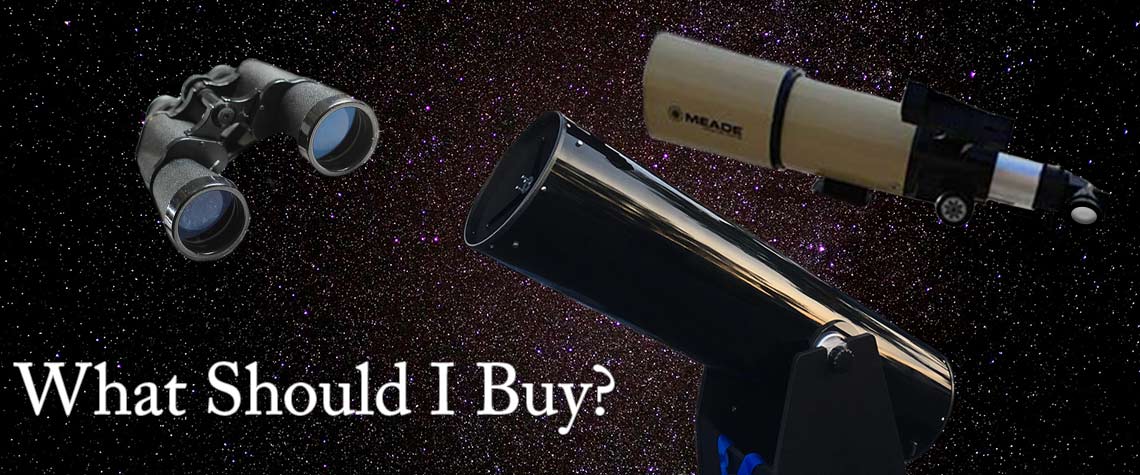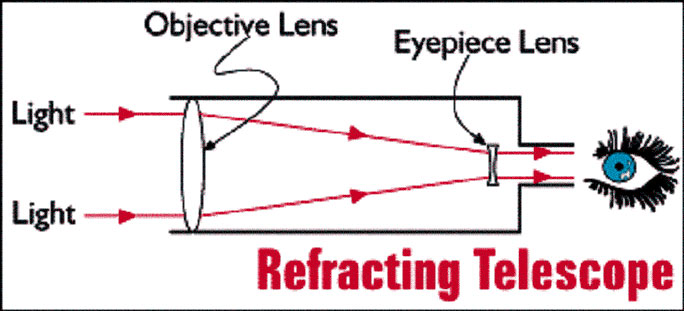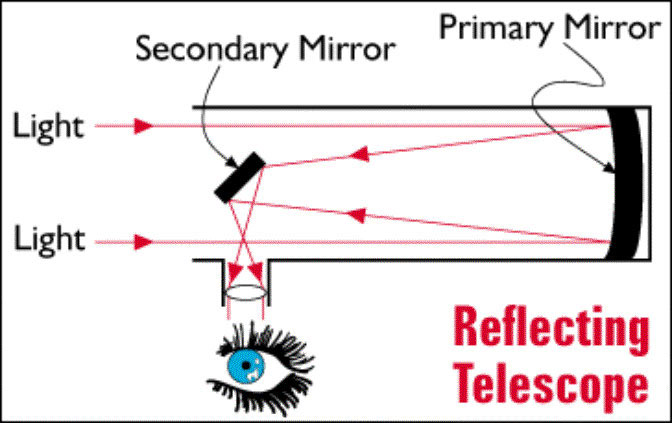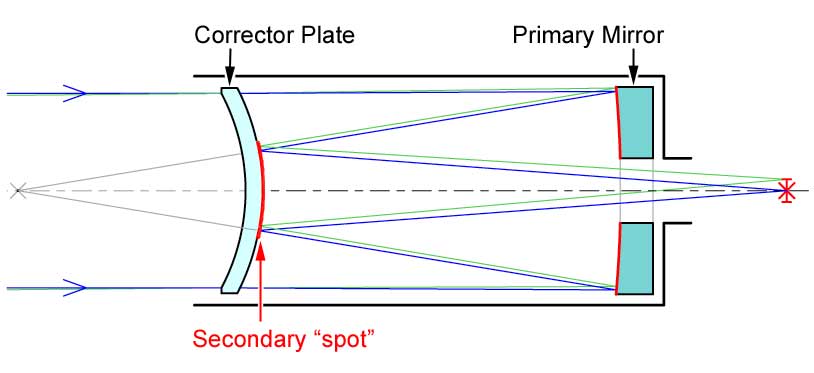Page 2


Choosing Your First Telescope
By Tom Campbell
One of the most frequent questions I get asked during star parties is, “Which telescope should I buy?” My quick answer is always, “That depends.” It sounds like a smart aleck answer, but there are a lot of factors that need to be considered.
I need to state right at the beginning that this article is not going to mention any specific brands or models. Rather, it will help steer you towards the type of telescope that will work best for you. Once you have that narrowed down, you can do Internet searches for reviews to narrow your choice to a specific model.
There's no such thing as a perfect telescope for everyone. In fact, there's no such thing as a perfect telescope for anyone. Like buying a car, they each have their share of advantages and disadvantages and the “best” one depends on what you want to use it for.
If you're going to be using it to haul stuff, you'd probably want a pickup or SUV. If you're going to be making a lot of long-distance trips, you'd probably want a hybrid or something that gets good gas mileage. If you want it as a prestige symbol, you might want to get a sports car or luxury car. So, my first follow-up question to this request usually is . . .
WHAT DO YOU WANT TO SEE?
There are many good reasons for wanting to get a telescope. Before you can decide on which telescope to get, you must first decide what you want to use it for. Studying the moon and planets? Observing faint galaxies? Bird watching? Zoom photography? A combination of these?
BINOCULARS
While contemplating these reasons, you may end up deciding you don't even need a telescope at all. Have you thought about binoculars? Perhaps a pair of binoculars would work as well or even better than a telescope. A decent pair of binoculars will allow you to see craters on the moon, Jupiter and some of its moons, several star clusters and even a few galaxies. Binoculars also have the advantage of being extremely portable. You can keep them in the car and have them ready at a moment's notice. Binoculars are just as good at viewing terrestrial objects as they are celestial objects.
Binocular Advantages:
- Small, lightweight and extremely portable
- Can view terrestrial or celestial objects equally well
- View is right-side up.
- Wide field-of-view
- Low cost compared to a telescope
Binocular Disadvantages:
- Can be difficult to aim, especially at celestial targets
- Only offers a single, low power view
- Handheld binoculars offer shaky views and mounted binoculars can be awkward.

Source: CC-BY-SA-3.0 (http://creativecommons.org/licenses/by-sa/3.0/), via Wikimedia Commons
If you decide that binoculars aren't going to cut it for you and you really need the extra magnification that only a telescope can provide, then read on.
TELESCOPES
How a Telescope Works
A telescope is designed to make far away things appear closer and brighter. To accomplish this, it has two basic parts: An objective lens (or primary mirror in a reflector) and an eyepiece. The objective lens has the function of capturing as much light as possible. The larger the objective, the brighter the object will appear.
For daytime use, the size of the objective lens isn't all that important, but at night when looking at celestial objects, a larger objective can help you see things that would otherwise be too faint for your eyes to detect. This lens (or mirror) is also curved, so that it bends the incoming light and narrows the beam so that the entire image will fit inside the human eye. As it travels down the length of the tube, the light eventually narrows to a point, which is called the focus. The eyepiece takes this focused beam of light and stretches it back out again (magnifies it) to take up a large portion of the retina of the eye that is looking through it.
TYPES OF TELESCOPES
There are three basic types of telescope, although each of these types have variations. Each type has its own set of advantages and disadvantages.
Refractor
When most people think of what a telescope looks like, a refractor is what comes to mind. Refractors are basically two lenses at opposite ends of a long tube. The larger lens (called the objective) is pointed towards the object and the person looks through the smaller lens (eyepiece). The objective lens is curved, causing the light to bend and come to focus right at the eyepiece.
Advantages:
- Simple and intuitive to use.
- Come in a variety of focal lengths
- Can easily be put on a variety of mounts
- Great for visual or astrophotography uses
- Can be used for terrestrial objects
- Low maintenance
- Aperture is unobstructed, providing brightest image
Disadvantages:
- Suffer from chromatic aberration
- More expensive than reflectors
- Heaviest telescope for a given aperture
- Longest tube required for a given aperture

Source: Wikimedia Commons
REFLECTOR
Like the name implies, reflectors use mirrors instead of lenses. A long, open tube contains a large, curved (primary) mirror at the bottom that reflects an image of the object back up the tube where it hits a flat secondary mirror mounted at the center of the tube, which then reflects the image sideways out of the tube and into an eyepiece where it can be seen.
Advantages:
- Cheaper than other types
- Somewhat portable compared to refractors of the same aperture
- Lightweight
- No chromatic aberration
- Best “bang for the buck”
Disadvantages:
- More difficult to use for astrophotography
- Upside down image makes it almost impossible to use for terrestrial use
- Mirrors have to be aligned (collimated) often for optimal performance
- Brighter stars will appear to have diffraction spikes

Source: Wikimedia Commons
COMPOUND
Compound or catadioptric telescopes use a combination of lenses and mirrors in an effort to get the best of both worlds. The most common types of catadioptric telescope are the Schmidt-Cassegrain and the Maksutov-Cassegrain.
Advantages:
- Compact and lighter than a refractor
- High power views from a short tube
- Great for visual and astrophotography
Disadvantages:
- Dimmest image for a given aperture
- May suffer from “image shift” when focusing
- Narrower field of view, making it more difficult to find objects

Source: CC-BY-SA-3.0 (http://creativecommons.org/licenses/by-sa/3.0/), via Wikimedia Commons
MOUNTS
Perhaps as important as the telescope itself is its mount. Put on a wobbly mount, even the best telescope becomes almost useless.
Altazimuth (alt-az)
This is the simplest type of mount. It allows the telescope to be pointed anywhere in the sky using two axes: vertical (altitude) and horizontal (azimuth).
Advantages:
- Easy to aim and use
Disadvantages:
- Auto-tracking computers for this type of mount are more expensive
- Not well suited for astrophotography
Dobsonian
The Dobsonian mount was developed in the 1970s and is named for its creator, John Dobson. It is a type of alt-az mount developed especially for large reflectors. Rather than sitting on a tripod, the mount sits on the ground, but otherwise has the same basic advantages and disadvantages of other alt-az mounts.
Equatorial
A gear-driven mount where one axis points towards the celestial north pole and the other axis rotates around it.
Advantages:
- Telescope follows motion of stars across the sky
- Tracking computers are much simpler and cheaper
Disadvantages:
- Must be aligned every time it is used
- Difficult to find objects without computer controls
FEATURES TO CONSIDER
By now, you should start to have an idea of what type of telescope will work best for you. Make sure you not only consider your current needs, but possible future needs as well. In no particular order, here are some other important things you should consider before making your final telescope selection.
Price
Most of us don't have an unlimited budget when it comes to a telescope purchase. Price is a good place to begin your search. The less you pay for a telescope, the more compromises you can be expected to have to make, but you can still get a quality telescope for under $100.
Aperture
Aperture is the amount of light that is collected for the image. This is determined by the size of the objective lens on a refractor and the primary mirror on a reflector. When deciding on a telescope, the general rule is you want the most aperture you can afford (and handle). In the amateur astronomy world, a popular phrase is “aperture is king.” The more aperture a telescope has, the more objects you will be able to see with it and the more details you will be able to see.
Aperture affects both the light-gathering power and the resolution of the telescope. It is usually expressed in terms of either inches or millimeters, and refers to the diameter of the objective or primary mirror. The light-gathering power is a function of the surface area of the objective and since the objective is circular, you can use the A = πr2 formula to compute it. For example, a 60mm (2.4 inch) objective will have a surface area of 2827 mm2 (4.5 in2). If you double the size of the objective (120mm or 4.8 inches), you quadruple the surface area to 11310 mm2 (18.1 in2). This light-gathering power translates to how faint an object you can see. This is called Limiting Magnitude.
Astronomers rank star brightness on an inverse magnitude scale. The lower the number, the brighter the star. Each magnitude is about 2.5 times brighter than the next magnitude higher. Therefore, a magnitude 4 star will be 2.52= 6.3 times brighter than a magnitude 6 star. On a dark night away from city lights, most people can see stars as faint as magnitude 6 and a few can see as faint as magnitude 7 with their naked eye.
The Limiting Magnitude of a telescope can also be calculated with a formula. Keep in mind, however, that this would be under ideal conditions - most of the time, local light pollution or turbulent air will reduce this number. The formula is L = 7.7 + (5 x Log(D)) where D is the diameter of the telescope in centimeters. For our 60mm refractor example, this becomes 7.7 + (5 x Log(6)) = 11.6. So, assuming we can see down to magnitude 6.6 with our naked eye, our telescope would allow us to see stars 2.55= 97 times fainter!
Resolution, on the other hand, is a function of the diameter of the objective. It refers to the angular distance two objects have to be in order to be seen as two distinct objects. This is called Dawe's Limit, and the actual formula to determine this is R = 1.22 λ/D, where R is the angular resolution (in radians), λ is the wavelength of light you are viewing, and D is the diameter of the objective. For most practical purposes, we can simplify this formula to 116 / D and get an answer in arc seconds (1/3600th of a degree). In order for this formula to work, the diameter D of the objective has to be expressed in millimeters.
Let's say we want to look at binary stars with our 60mm telescope. In ideal sky conditions, we would be able to detect stars as close as 116 / 60 = 1.93 arc seconds. If we doubled the size of our objective lens, we would be able to detect stars as close as 116 / 120 = 0.97 arc seconds.
Magnification
Contrary to popular belief, magnification is one of the least important factors to consider when buying a telescope. It should be noted that magnification will never increase the amount of detail you can see - it only makes the details larger. Magnification can be calculated by taking the focal length of the telescope divided by the focal length of the eyepiece. If your telescope has a focal length of 1000mm and you pop in a 10mm eyepiece, the object you look at will appear 1000/10 = 100 times (denoted 100X) closer than they do with the naked eye. Similarly, if you put a 20mm eyepiece in that same telescope, objects would only appear 1000/20 = 50x closer. The larger the number on the eyepiece, the smaller the magnification.
Also note that if you use the exact same eyepiece in a different telescope, it could result in a different magnification. For example, if you put the 10mm eyepiece in a telescope that has a focal length of 1500mm, it will show objects at 150X. It sounds like you'd want some tiny 1mm and 2mm eyepieces so you can get enormous magnifications from your telescope, but I'm afraid there are some caveats.
First, the more you magnify an object, the dimmer it will appear. On the moon and planets, this isn't such a big deal because they are pretty bright to begin with. On the other hand, most galaxies are so far away, they appear as a faint smudge at low power and completely disappear at higher magnification.
Second, the higher the magnification, the narrower the field of view. If you put in a low-power eyepiece, it is relatively easy to find objects, as you can aim “fairly close” to the target and it should appear somewhere in the eyepiece. With a high-power eyepiece, you are seeing less of the sky, so your aim has to be a lot more precise to get the object in the field.
Third, you are not only magnifying the object you want to look at, but also Earth's atmosphere. Tiny air currents that you can't even see at 10X will bloom into large motions at 100x and can cause the image to appear to boil and distort. This makes precise focus more difficult and objects will start to appear more “mushy” as you go to higher and higher magnifications. This turbulence will vary from night to night, from location to location, and even from minute to minute. Some nights, the air in the upper atmosphere will be still and you may be able to push your telescope to unbelievable magnifications. Other nights, you will barely be able to see anything, even at low power.
Highest Useful Magnification
Astronomers have come up with a number they call “highest useful magnification” for a telescope. A good rule of thumb for this number is 50 times the telescope's aperture (if using inches) or 2 times the telescope's aperture (if using millimeters). So an 80mm telescope will have a maximum useful magnification of 2 x 80 = 160X. Keep in mind that there will be many nights when even this magnification will be too much for the atmospheric conditions.
Portability
If you're planning on putting the telescope inside a personal observatory or permanently mounting it on a concrete pier, this factor may not be important. Otherwise, you will have to decide how much telescope you are willing and able to handle. If you are only planning on observing in your back yard or in your driveway, you can get by with dragging a big telescope out of the garage when the weather is good. If you want to occasionally take your telescope out to a dark sky site to get the most out of it, make sure it will fit in your vehicle and that you can unpack it and pack it back up again in the dark. If your main observing site has a lot of trees or street lights to contend with, you will want something very portable so that you can pick up the scope and move it around as needed to give yourself a good line of sight to your target.
Ease of Use
Another oft-used phrase in amateur astronomy circles states “the telescope that is best for you is the one that you will use the most.” This has a lot of truth in it. A $10,000 behemoth telescope may show you unbelievable details, but if you shudder every time you think of moving it out into the driveway, it will end up sitting in your garage for years unused. It is much better to buy something smaller that is simple to set up at a moment's notice, and that you can enjoy every time the mood strikes you.
Quality
No one wants to buy something only to get it home and find out that it's junk. Most people plan on using their telescopes for years and possibly even passing them on to their children. In general, metal parts are better than plastic, but of course are also heavier. Lenses should always be glass instead of plastic. A parabolic primary mirror is better than a spherical primary mirror.
Solid Mount
A wobbly mount can make even the highest-quality telescope nearly useless. This is most noticeable on telescopes that are mounted on tripods. Often in a cheap telescope, the optics are actually decent, but the mount is lightweight and too “underpowered” for the weight of the telescope. If you can tap on the telescope and it shakes for more than 1-2 seconds, the mount is insufficient.
There are ways to make a shaky tripod sturdier. For instance, hanging weights from the middle of the tripod will lower the center of gravity and create a more stable platform. You can also buy rubber vibration suppression pads that fit under each leg of the tripod to reduce shaking.
Many people find that they spend more money on their mount than they do the actual telescope, but the steady images bring out the best in their equipment and make the price worthwhile.
Upgradability
Another thing to consider is how easy it will be for your telescope to “grow with you” as your astronomy skills increase and your needs change. One of the most important aspects of this concerns a telescope's eyepieces. As was mentioned earlier, the eyepiece is what magnifies the image in a telescope. If you want to see objects at different magnifications, you will need multiple eyepieces. All eyepieces have a barrel at the bottom that fits into the focuser of the telescope. These barrels come in different sizes, so you have to make sure you can find eyepieces that will fit your focuser.
Many vintage telescopes have a barrel size of 0.965 inches and you will still see this size sometimes on “department store” telescopes. Most good telescopes today will have either 1.25“ or 2“ focusers. They also make an adapter ring that will allow a 2“ focuser to accept a 1.25“ eyepiece. 1.25“ and 2“ eyepieces are more plentiful and usually better quality than their 0.965“ counterparts, making telescopes that support one or both of those sizes a better choice.
Also, you may someday want to try your hand at astrophotography. Will your telescope allow you to attach a camera to it? Refractors and catadioptric telescopes are usually best suited to attaching a camera to the focuser. It can be done on reflectors, but this will make the telescope “top-heavy” and an equal amount of counterweight will need to be added to the primary mirror end.
CONCLUSION
Picking out your first telescope can seem a daunting task, but if you keep in mind what you want to use it for, the task becomes much easier. Every telescope has its own set of strengths and weaknesses and by matching these up to your goals, you can get a nice instrument that will serve you well for many years.
